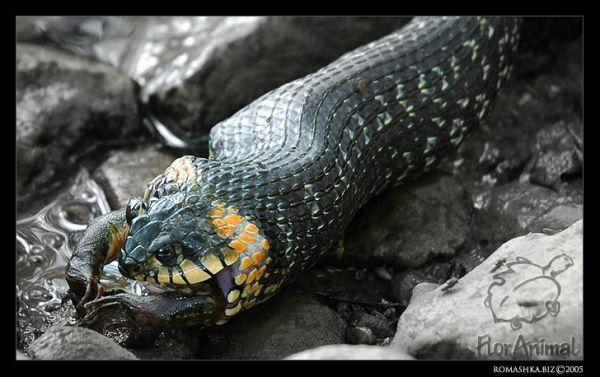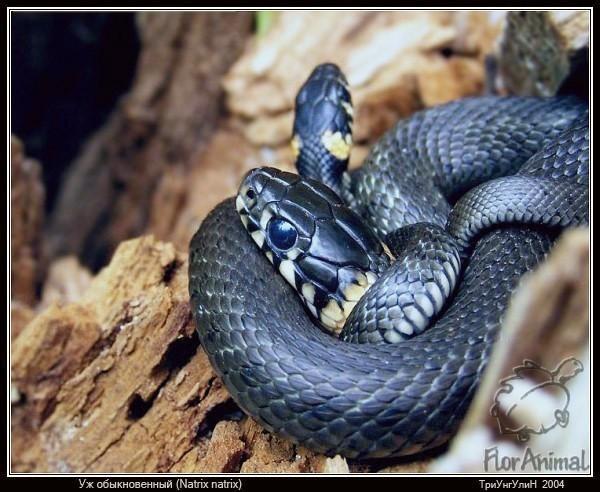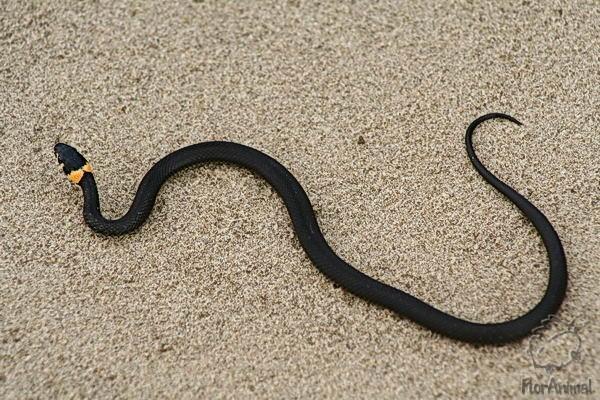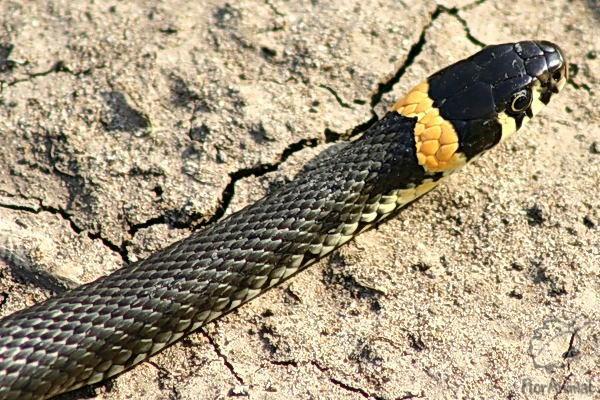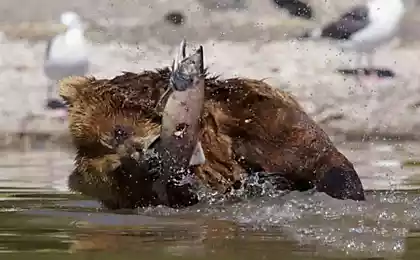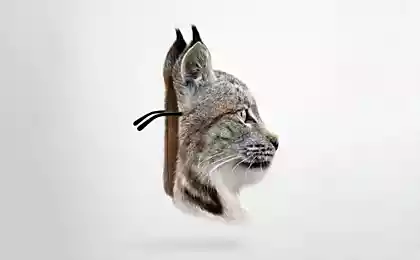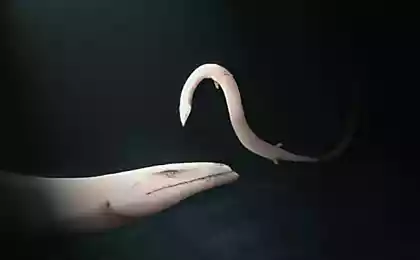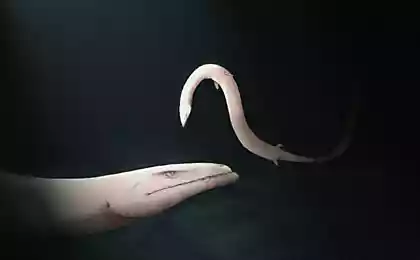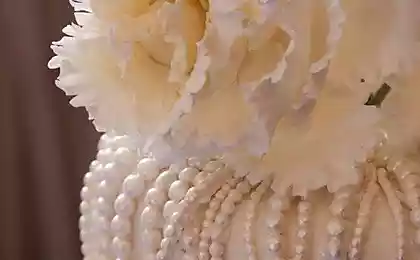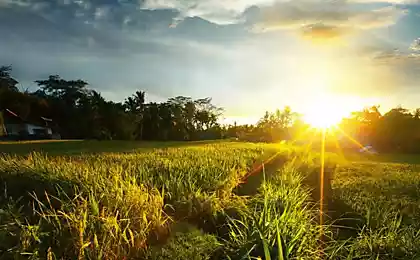1297
UZH (Natrix natrix)
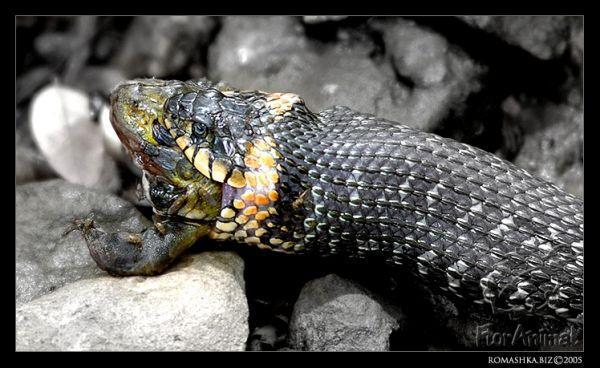
UZH (Natrix natrix) the most famous and widely distributed species of the genus. Oh, well different from all our other two large snakes, highly visible light spots (yellow, orange, off-white), located on the sides of the head. Spot these are crescent-shaped and the front and back are bordered by black stripes. Sometimes, there are individuals who have light spots are mild or absent. The color of the upper side of the body of the snake is dark gray or brown to black, the belly is white, but the midline abdominal stretches irregular black stripe that some individuals are so extended that displaces almost all white, preserved only in the throat. The body length of the snake can reach 1, 5 m, but is typically less than 1 m; females are much larger than males. Already inhabited North Africa, all of Europe, except the northernmost parts of it, and Asia as far east as central Mongolia. Further, all other kind of really moving to the north, in Scandinavia almost reaches the Arctic Circle. The southern boundary of the area passes through South and Central Iran Palestine. In Russia occupies the entire European part of the country, reaching the South Karelia, Perm and Chelyabinsk regions, Siberia, to the east - to the Trans-Baikal. It is found in the Southwest and East Kazakhstan, Turkmenistan. Snake habitats are very diverse, but certainly quite wet. Especially numerous snakes along the banks of the calm rivers, lakes, ponds, grassy marshes, humid forests and floodplain meadows covered with scrub, but there are sometimes even in the open steppe and mountains. Often living in orchards, gardens, farmyards, and sometimes crawl into various outbuildings. In the spring, as well as in autumn, when the soil holds plenty of water, snakes can go far from water. Shelters snakes are void under the roots of trees, piles of stones, burrows of rodents, haystacks, the gap between the logs bridges, dams and other shelters. Sometimes snakes settled in the cellars under the houses, heaps of manure or litter. The fallen leaves and loose ground snakes are free to make its moves. Ordinary snakes are very active, moving the snake. Fast crawling, can climb trees and swim very well using typical for snakes lateral bending of the body. Snakes can be removed from the coast for many kilometers and several tens of minutes to be without surfacing, underwater. Typically, float, raising his head above the water and leaving a distinctive ripple, so moving over the pond snakes are clearly visible. Snakes are active in the daytime, and at night hiding in shelters. They hunt mainly in the morning and evening hours. Happy love to bask in the sun, curled up in the creases of reeds, rocks, bent over the water, the trees, bumps, nests of water birds. In the hottest time, especially in the south, hidden in the shade or go down into the water, where they can lie on the bottom for a long time. By pairing snakes begin in late April - May, after the first spring molt. In July - August females lay one portion from 6 to 30, the soft-coated parchment eggs which are often bonded together like beads. Eggs are easily killed by drying, so the snake lay them in moist but well maintained warm (25-30 °) seekers: under the fallen leaves in damp moss, manure heap, and even garbage, abandoned burrows of rodents, rotten stumps. Sometimes, especially with a lack of suitable shelter, in the same place several females lay eggs. A case where a lay on the forest glade of the old door was found more than 1200 snakes eggs arranged in several layers. The initial stages of the development of the embryo snake goes back in the mother's body, and that the only pending eggs visible to the naked eye throbbing heart of the embryo, incubation lasts about 5-8 weeks. Young snakes at hatching are about 15 cm length; they immediately crawl and begin to lead an independent life. The young are much more secretive way of life than adults, and catch the eye is relatively rare. In winter, snakes hide in deep burrows of rodents, in the cracks of coastal cliffs, under the roots of rotten trees. Sometimes winter alone, often several individuals together, not avoid close proximity of other species of snakes. Hibernation relatively late, in October - November, when it starts freezing night. Waking from hibernation takes place in March - April. On warm days the snakes begin to crawl out of their winter shelters and long basking beside them in the sun, sometimes going into balls for many special together. Every spring day snakes become more active and is gradually creeping to the wintering grounds. In Eastern and Northern Europe hibernation snakes continued to 8-8, 5 months, slightly less than in the south. Middle-sized snakes feed on frogs, toads and their young. Occasionally they become prey to lizards, small birds and their chicks, as well as small mammals, including young infants water rats and muskrats. Young snakes often catch insects. The popular belief that snakes feed on fish and are very harmful to fish farming, based on a misunderstanding. Small fish eaten by these snakes rarely and in small amounts. Even in the fish-rich waters of snakes sometimes swim among these dense swarms of young fish that just pushes them with his body, and yet in the stomachs of captured snakes are not able to find the fish, and only the young frogs. In one hunt too big to swallow up to 8 frogs or large lake frog tadpoles. Frogs that have plagued so, behave in a very peculiar: although it would be easier to save more jumps, they make short and rare racing and gave a cry, quite unlike the sounds that we are used to hearing from them. This cry is more like the plaintive bleating of sheep. Harassment is rarely lasts long, and usually the snake soon overtake its prey, grabs her, and immediately begins to swallow alive. Grass snake is trying to grab a frog over his head, but often it fails, he grabs her by the hind legs and slowly drawn into the mouth. Frog pounding and publishes croaking sounds. Small frogs too easy to swallow, but devouring large animals he sometimes spends a few hours. If uzhu threatened, he usually vomits, like other snakes, swallowed prey, and widely opens mouth if swallowed animal was great. There have been cases that snakes belching live frogs, which, despite the fact that he had been in his throat snake, found themselves in the future is quite viable. Like all snakes, garter snakes are capable of for a long time without food. A case where the snake without harming themselves starved more than 300 days. Drink snakes, especially on hot days, very much. Enemy at snakes very much. They are eaten by eagles, serpent eagle, storks, vultures and many predatory mammals (raccoon dogs, foxes, minks, martens). Serious enemy of snakes and rats are also eating the clutch pressed down and the young. From snakes person always trying to escape by flight. Not being able to crawl, sometimes (especially larger ones) take a threatening posture: roll up into a ball, and from time to time with a loud hiss head thrown forward. Being trapped, snakes bite, but only in extremely rare cases, causing the teeth easily, quickly healing scratches. The only way to protect the snakes should be considered extremely smelly yellowish-white liquid, which they are discharged from the cloaca. In many cases, the snake quickly caught cease resistance, rolls of stomach production, if any was eaten recently, and then fully rasslablinet body widely raskryvaet`past and with his tongue hanging limply hangs in your hands or on your back is turned. This state of "apparent death" passes quickly, if you throw a snake in the water or just left alone. Snakes live well in captivity, quickly begin to take food offered to them and soon made quite tame. They need water for drinking and bathing.
